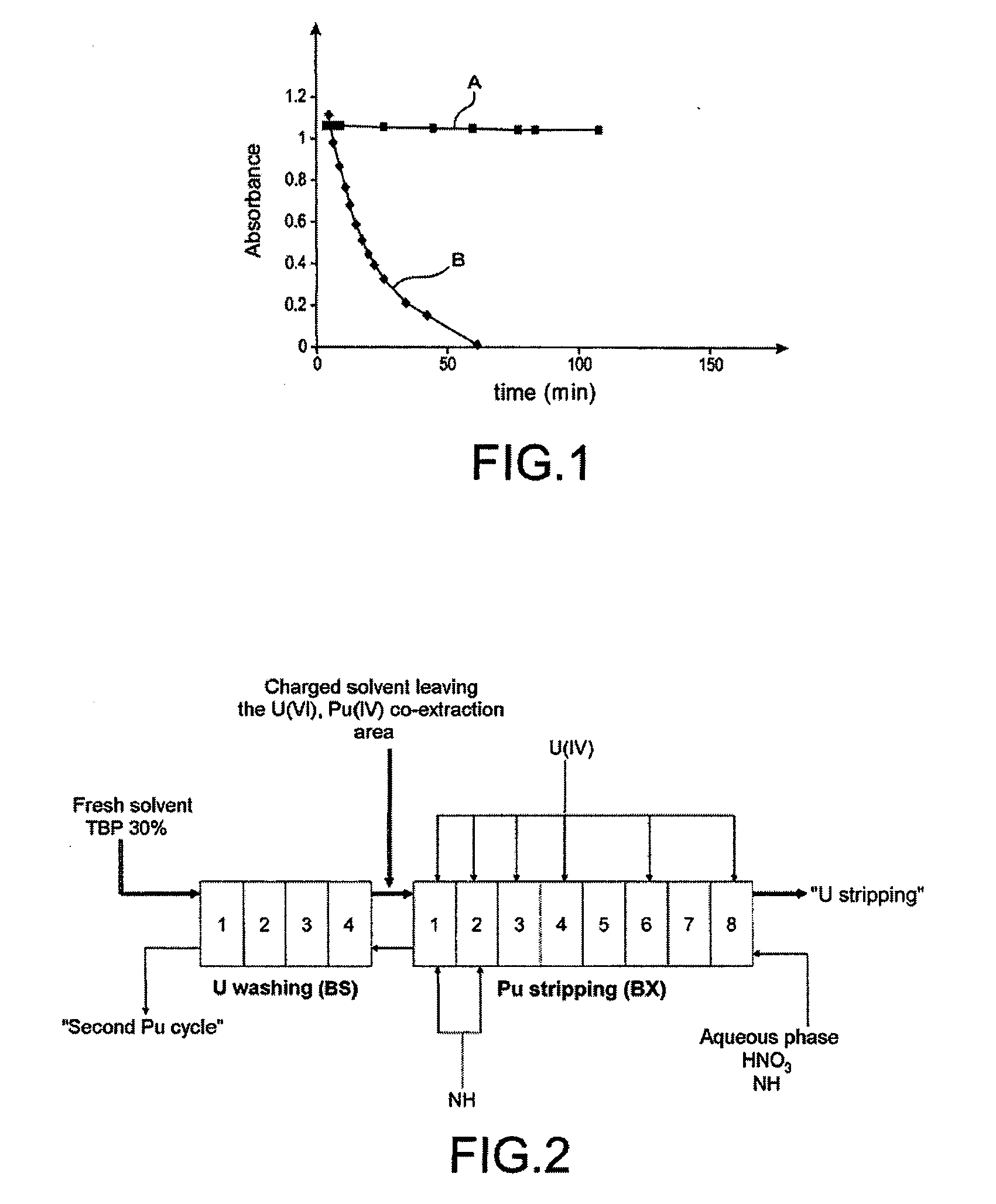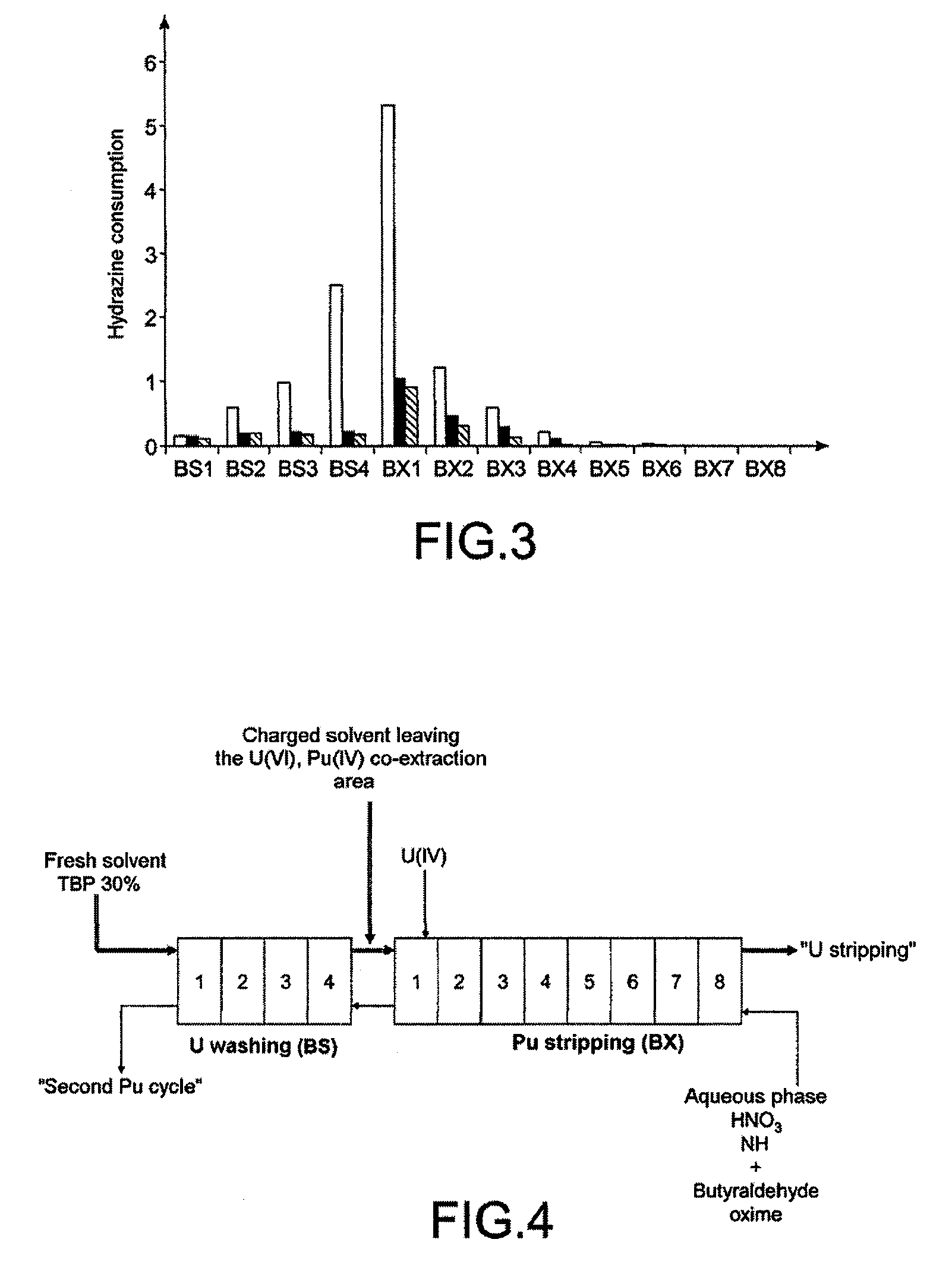Use of Butyraldehyde Oxime as an Anti-Nitrous Agent in an Operation for the Reductive Stripping of Plutonium
a plutonium stripping and nitrous agent technology, applied in the direction of inorganic chemistry, nuclear energy generation, separation processes, etc., can solve the problems of large reagent consumption and additional exploitation constraints
- Summary
- Abstract
- Description
- Claims
- Application Information
AI Technical Summary
Benefits of technology
Problems solved by technology
Method used
Image
Examples
example 1
Demonstration of the Extractability and of the Anti-Nitrous Power in Solvent Phase of Butyraldehyde Oxime
[0044]The capacity of butyraldehyde oxime to be extracted into solvent phase and to destroy nitrous acid therein was demonstrated by two different tests of reductive stripping of plutonium with uranous nitrate: a first test that was performed under conditions simulating the functioning of a mixing-decanting stage, and a second test that was performed in a laboratory centrifugal extractor.
1) Test Simulating the Functioning of a Mixing-Decanting Stage:
[0045]This test consists in:[0046]preparing an aqueous phase containing:[0047]25 g / l of Pu(IV),[0048]2.5 mol / l of nitric acid,[0049]0.1 mol / l of hydrazine, and[0050]0.5 mol / l of an oxime,[0051]this oxime being either butyraldehyde oxime or acetaldoxime of formula: CH3—CH═N—OH;[0052]equilibrating this aqueous phase with a solvent phase composed of TBP at 30% (v / v) in TPH (which is itself pre-equilibrated with a nitric acid solution of ...
example 2
Application of the Invention to a Reductive Stripping of Plutonium in Mixer-Decanters
[0084]Butyraldehyde oxime may advantageously be used in an operation for the selective stripping of plutonium in a first decontamination cycle of a process of Purex type with partition of the U / Pu streams.
[0085]This is an operation that typically uses uranous nitrate as reducing agent and hydrazine as anti-nitrous agent, and which is employed in mixer-decanters.
[0086]As shown in FIG. 2 which schematically represents this operation, the solvent phase charged with U(VI) and Pu(IV) arriving from the co-extraction area of the cycle enters the area known as “Pu stripping”, noted BX, which includes 8 mixer-decanter stages.
[0087]At each stage, this solvent phase is mixed with an aqueous nitric phase of low acidity (0.05 M to 2 M) containing uranous nitrate and hydrazine, and is then separated from this phase.
[0088]The aqueous phase leaving the “Pu stripping” area enters the area known as “U washing”, noted...
PUM
| Property | Measurement | Unit |
|---|---|---|
| concentration | aaaaa | aaaaa |
| affinity | aaaaa | aaaaa |
Abstract
Description
Claims
Application Information
 Login to View More
Login to View More - R&D
- Intellectual Property
- Life Sciences
- Materials
- Tech Scout
- Unparalleled Data Quality
- Higher Quality Content
- 60% Fewer Hallucinations
Browse by: Latest US Patents, China's latest patents, Technical Efficacy Thesaurus, Application Domain, Technology Topic, Popular Technical Reports.
© 2025 PatSnap. All rights reserved.Legal|Privacy policy|Modern Slavery Act Transparency Statement|Sitemap|About US| Contact US: help@patsnap.com


